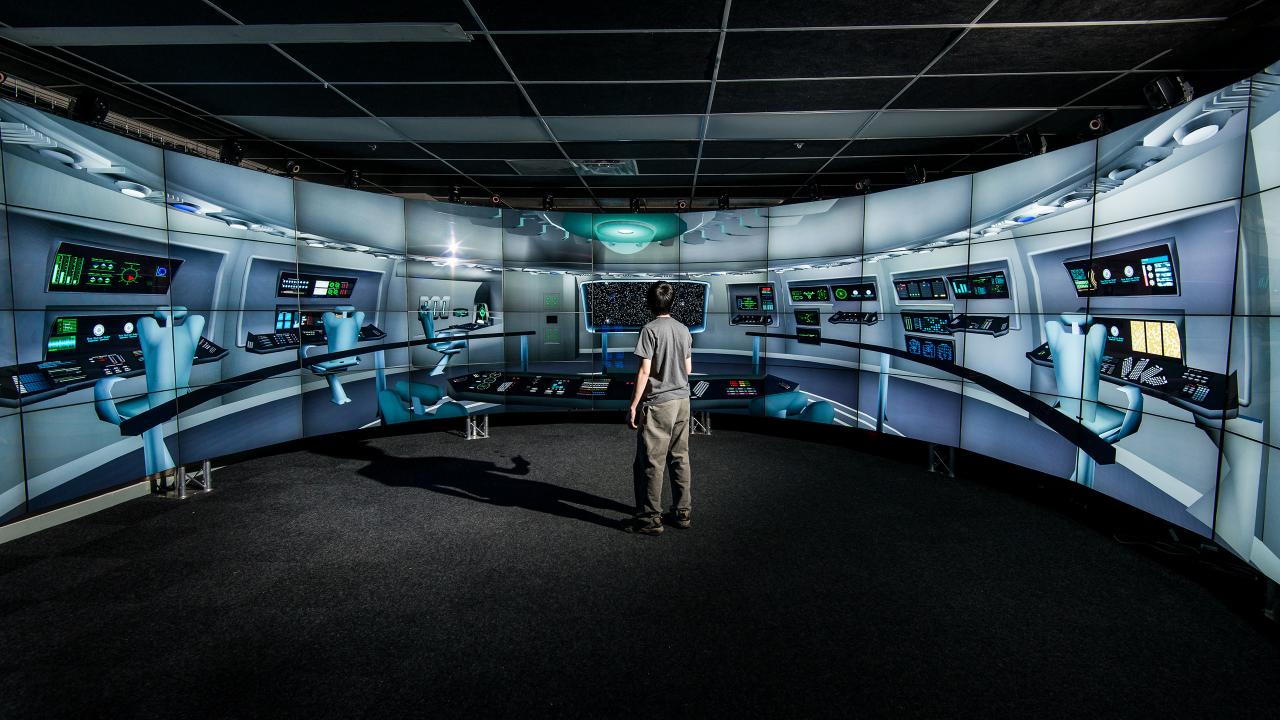|
|
||||||||||||||||||
CAVE2: Next-Generation Virtual-Reality and Visualization Hybrid Environment for Immersive Simulation and Information Analysis
Researchers: Alan Verlo, Alessandro Febretti, Andrew Johnson, Dana M. Plepys, Daniel J. Sandin, Jason Leigh, JD Pirtle, Jonas Talandis, Lance Long, Luc Renambot, Maxine Brown, Tom Peterka
Funding: NSF CNS-0959053 and DOE DE-SC005067 CAVE2™, the next-generation large-scale virtual-reality environment, is a hybrid system that combines the benefits of both scalable-resolution display walls and virtual-reality systems to create a seamless 2D / 3D environment that supports both information-rich analysis as well as virtual-reality simulation exploration at a resolution matching human visual acuity. CAVE2 creates new opportunities for users to collaborate using both 2D and 3D. Today, all science is e-science: computers capture, filter, analyze and visualize data from instruments and simulations. CAVE2 serves as the lens of a virtual “telescope” or “microscope” enabling users to simultaneously see and analyze one or more e-science datasets that reside in cyberspace. CAVE2 benefits large-scale collaboratories of discipline scientists in need of advanced cyberinfrastructure, providing them with new and more intuitive ways of interacting with their data. In addition, CAVE2 benefits computer scientists interested in providing knowledge workers with better ways to manage the scale and complexity of their data, by enabling them to study a wide range of new problems at the intersection of human-computer interaction, virtual reality, computer graphics, high-performance computing, high-speed networking, and computer-supported cooperative work. CAVE2 was developed by the Electronic Visualization Laboratory (EVL) at the University of Illinois at Chicago (UIC), a renowned interdisciplinary research laboratory that pioneered the development of the CAVE virtual-reality system (1992) and the OptIPortal scalable-resolution display wall (2004-present). These displays, deployed to hundreds of research, industrial and educational researchers and developers worldwide, enable users to see and navigate through complex datasets. Classic CAVEs are virtual-reality rooms with stereoscopic 3D computer graphics rear-projected onto the walls and down-projected onto the floor. OptIPortals are tiled display walls. Today, both are powered by computer clusters connected to high-speed networks to enable users to better cope with information-intensive tasks. The CAVE immerses people into worlds too large, too small, too dangerous, too remote, or too complex to be viewed otherwise. The OptIPortal creates a virtual “project room” in which people can display very-large images and/or simultaneously juxtapose more information, and better spatially organize, see and infer relationships among the data. The CAVE2 merges the major benefits of the CAVE and OptIPortal into a single unified environment. CAVE2 is programmable using a number of application programming interfaces. While some are virtual-reality only, it is EVL’s SAGE (Scalable Adaptive Graphics Environment), that enables CAVE2’s huge wall to be partitioned into “windows” - enabling one or many 2D and 3D windows of information to simultaneously be displayed. CAVE2 is approximately 24 feet in diameter and 8 feet tall, and consists of 72 near-seamless passive stereo off-axis-optimized 3D LCD panels, a 36-node high-performance computer cluster, a 20-speaker surround audio system, a 10-camera optical tracking system and a 100-Gigabit/second connection to the outside world. CAVE2 provides users with a 320-degree panoramic environment for displaying information at 37 Megapixels in 3D or 74 Megapixels in 2D with a horizontal visual acuity of 20/20 - almost 10 times the 3D resolution of the original CAVE. The development of CAVE2, also referred to as the Next-Generation CAVE (NG-CAVE), has been funded by the National Science Foundation’s Major Research Instrumentation (MRI) program, award # CNS-0959053 and the Department of Energy, agreement # DE-SC005067. Grants such as these enable EVL to continue to provide state-of-the-art visualization instrumentation to research scientists and educational opportunities to UIC students. EVL’s visualization and virtual-reality instruments are developed by its faculty, staff and students, and used by approximately 11 EVL-affiliated UIC departments in Computer Science, Geoscience, Medicine, Communications, Education, and Art. These instruments enable graduate students to conduct research toward their degrees, and attract and inspire undergraduates to pursue graduate degrees. Additionally, EVL has engaged scores of children through its outreach efforts with the public schools and museums. CAVE2 debuted October 2012. Videos showcasing CAVE2 applications. CAVE2 is a trademark of the University of Illinois Board of Trustees. Date: May 1, 2009 - Ongoing |